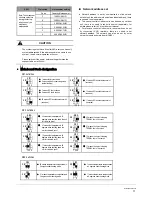
7
installation manual
7. REFRIGERANT PIPE CONNECTION
7.1 Expel The Air
Locate The Pipe
Drill a hole in the wall (suitable just for the size of the wall conduit,
90mm in general), then set on the fittings such as the wall conduit
and its cover.
Bind the connecting pipe and the cables together tightly with
binding tapes. Do not let air in, which will cause water leakage
by condensation.
Pass the bound connecting pipe through the wall conduit from
outside. Be careful of the pipe allocation to do no damage to the
tubing.
Connect the pipes.
Then, open the stem of stop valves of the outdoor unit to make
the refrigerant pipe connecting the indoor unit with the outdoor
unit fluently flow.
Be sure of no leakage by checking it with leak detector or soap
water.
Cover the joint of the connecting pipe to the indoor unit with the
sound proof/insulating sheath (fittings), and bind it well with the
tapes to prevent leakage.
●
●
●
●
●
Flaring
Cut a pipe with a pipe cutter.
Insert a flare nut into a pipe and flare the pipe.
Fig.7-1
Fig.7-2
Fig.6-1
Use refrigerant oil
Bend the pipe with thumb
Make the ends
straight
Fig.6-3
Fig.6-2
R0.4~0.8
45 ° ±
2
90 °
± 4
A
Lean crude burr
●
●
Fasten the nut
Put the connecting tubing at the proper position, wrench the
nuts with hands then fasten it with a wrench. (Refer to
Fig.7-3
)
Too large torque will harm the bellmouthing and too small will
cause leakage. Please determine the torque according to
Table.7-2.
Outside diameter
A(mm)
Max
8.7
Φ6.4mm
Φ9.5mm
Φ12.7mm
Φ15.9mm
Φ19.1mm
12.4
15.8
19.0
23.3
8.3
12.0
15.4
18.6
22.9
Min
Table.7-1
Torque
Tubing size
14.2~17.2N.m
32.7~39.9N.m
49.5~60.3N.m
61.8~75.4N.m
97.2~118.6N.m
Φ6.4mm
Φ9.5mm
Φ12.7mm
Φ15.9mm
Φ19.1mm
Table.7-2
Fig.7-3
































